Designing reflection activities
Reflection is an important activity for students to be able to make sense of and grow from a learning experience. Reflection is essential for deep learning (that is, learning with understanding), consolidating learning, and helps students with metacognition (learning how to learn).
Students may be asked to reflect ‘on-action’ or ‘in-action’ (Schön 1983) - a simple way of distinguishing this is by when the reflection occurs. Reflection in-action, requires students to consider the situation, decide how to act and act immediately. Reflection on-action is about re-considering the situation and planning for altered approaches should the situation reoccur – this has allowed for several different (but similar in principle) models of reflection to emerge.
Boud et al. (1985) place special emphasis on the relationship between reflection, the learning the experience and the outcomes of that experience. In the case of reflection on-action, returning to the experience, attending to feelings and re-evaluating the experience are central to this process. This relationship is evident in all models listed below.
Models of reflection
Reflection is most effective when it takes place as a structured activity. Using a reflection model can be especially useful for establishing reflective practice - especially for students new to reflection (for example, in the first years of undergraduate study). Some models are suitable to some disciplines or learning and teaching approaches more than others – finding the one that students are likely to respond to is at the very least a good start.
These models guide students through the process of reflection or introduce the practice in a structured way to students who are less familiar. The list below is indicative so you may want to explore others or use one that are familiar with:
- Driscoll’s Model of Reflection
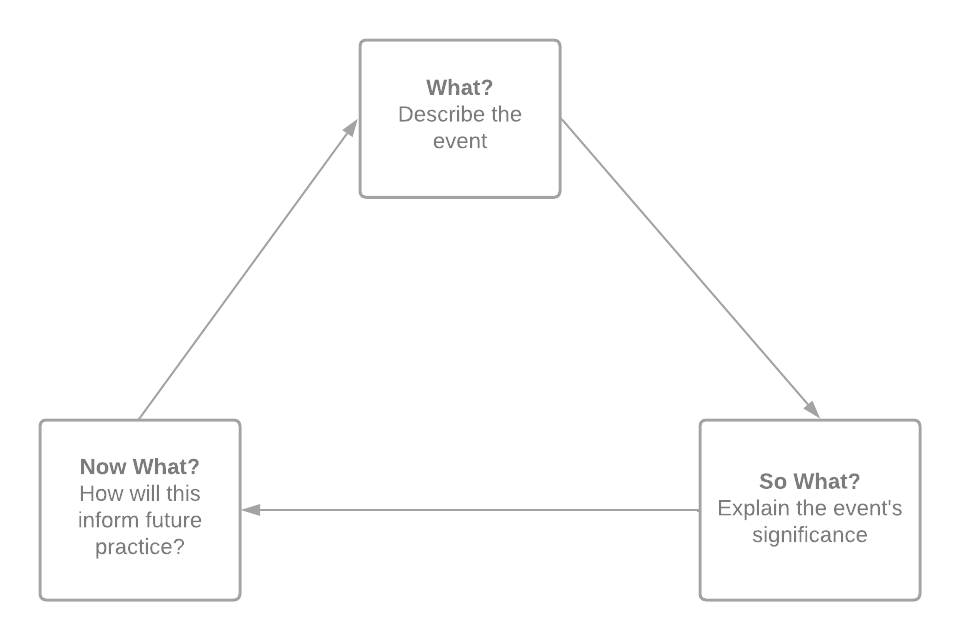
What… So what… Now what… Questions to help with the description of the event/experience Questions to help with the understanding of the event/experience Questions to help with what can be done to improve the experience …is the problem? or
…is the reason for this difficulty?
…does this tell me about me about:
- me?
- my patient/student?
- others?
- our relationship?
- my patient’s care?
- the model of care/teaching approach I am using?
- my attitudes?
- my patient’s/student’s attitudes?
…do I need to do in order to:
- make things better?
- stop being stuck?
- improve my patient’s care?
- resolve the situation?
- feel better?
- get on better?
…was my role in this situation?
…was going through my mind as I acted?
…broader issues need to be considered if this action is to be successful?
…was I trying to achieve?
…did I base my actions on?
…might be the consequences of this action?
…actions did I take?
…other knowledge can I bring to the situation?
- experience
- personal
- scientific
…was the response of others?
…could I have done to make it better?
…were the consequences?
- for the patient/student?
- for myself?
- for others?
…is my new understanding of the situation?
…feelings did it evoke?
- in the patient/student?
- in myself?
- in others?
…broader issues arise from the situation?
…was good (or bad) about the incidence or experience?
Driscoll, J.J. (2007) Supported reflective learning: the essence of clinical supervision? Chapter 2 in Practising Clinical Supervision: A Reflective Approach for Healthcare Professionals (2nd edition). London: Bailliere Tindall. pp 27-‐50.
- Kolb's Experiential Learning Cycle
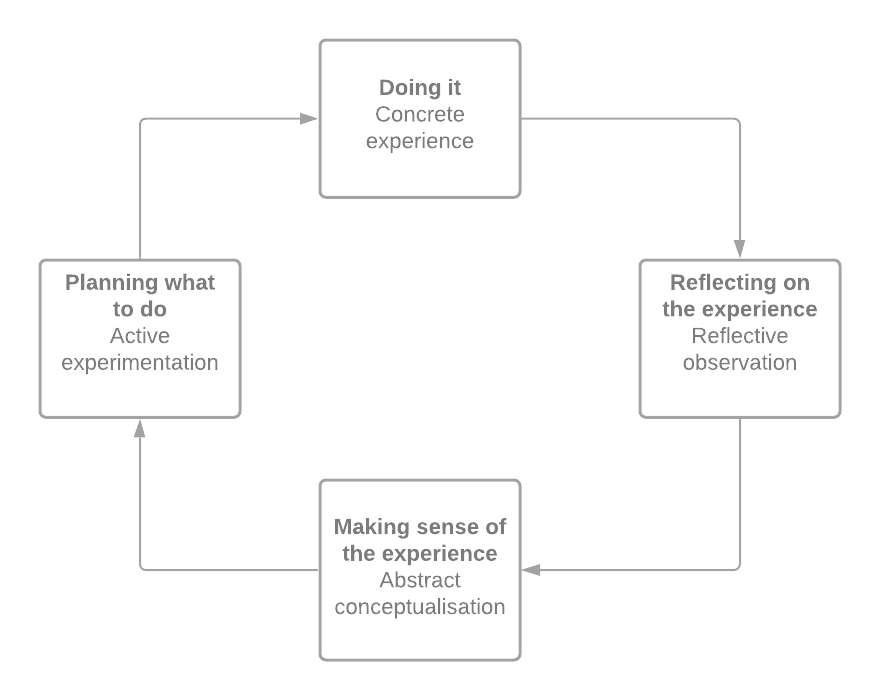
Example question prompts
Doing it
What happened?
- What did you do? Where did it happen? Who was involved? What was the context?
Reflecting on the experience
What were you thinking and feeling?
- Describe your internal thoughts and feelings before, during and after the event
Making sense of the experience
What was good and bad about the experience?
- Were there things that were difficult? Interesting? Surprising? Upsetting? Provide some judgement about the event and its possible consequences
Planning what to do
- What would you do if a similar situation arose again?
- What are some indicators that would help you recognise a similar event?
- What are some changes you would make?
Kolb DA. Experiential learning: experience as the source of learning and development. Englewoods Cliffs, N.J.: Prentice Hall, 1984.
- Johns' Model of Reflection
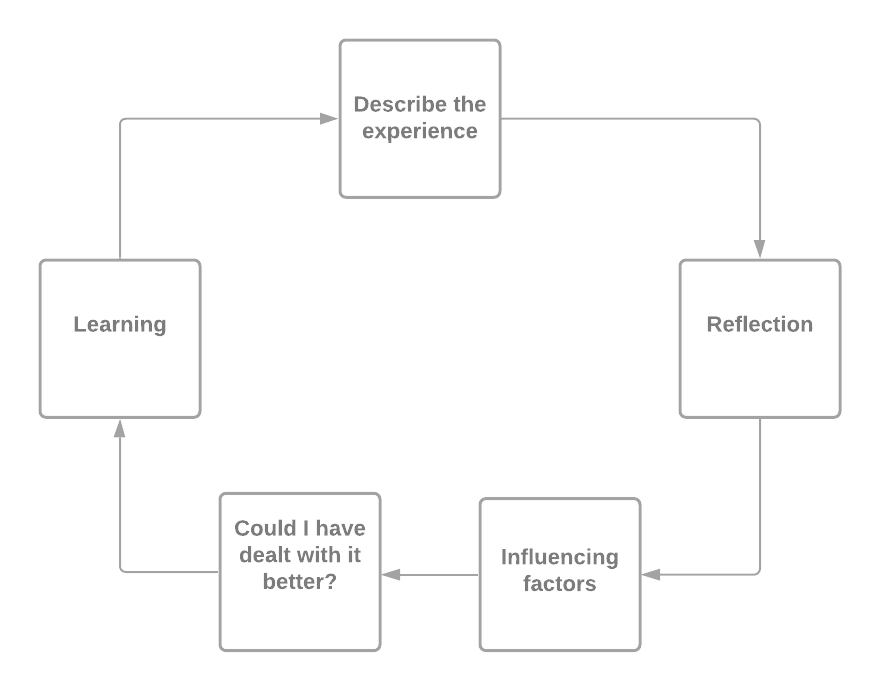
Example question prompts
Describe the experience - Describe the experience, and the significant factors that were involved?
Reflection - What was I trying to achieve?
- What were the consequences of my actions?
- How did I feel about this experience when it was happening? Why did I feel this way?
- If there was another person involved (e.g., a patient), how did they feel about the situation?
Influencing factors - What things (e.g., internal factors, my own knowledge, external factors) affected my decision making and actions?
Could I have dealt with it better? - What other choices did I have?
- Did I act for the best?
- What would the consequences of those other actions have been? For myself? For others?
Learning - What will change because of this experience?
- How do I now feel about the experience?
- How has this experience changed my ways of knowing?
- Empirics (scientific)
- Ethics (moral knowledge)
- Personal (self-awareness, e.g., of my own beliefs and values)
- Aesthetics (the art of what we do, our own experiences)
Johns C. Becoming a reflective practitioner: a reflective and holistic approach to clinical nursing practice, development and clinical supervision. Oxford: Blackwell Science, 2000.
- Atkins and Murphy’s Model of Reflection
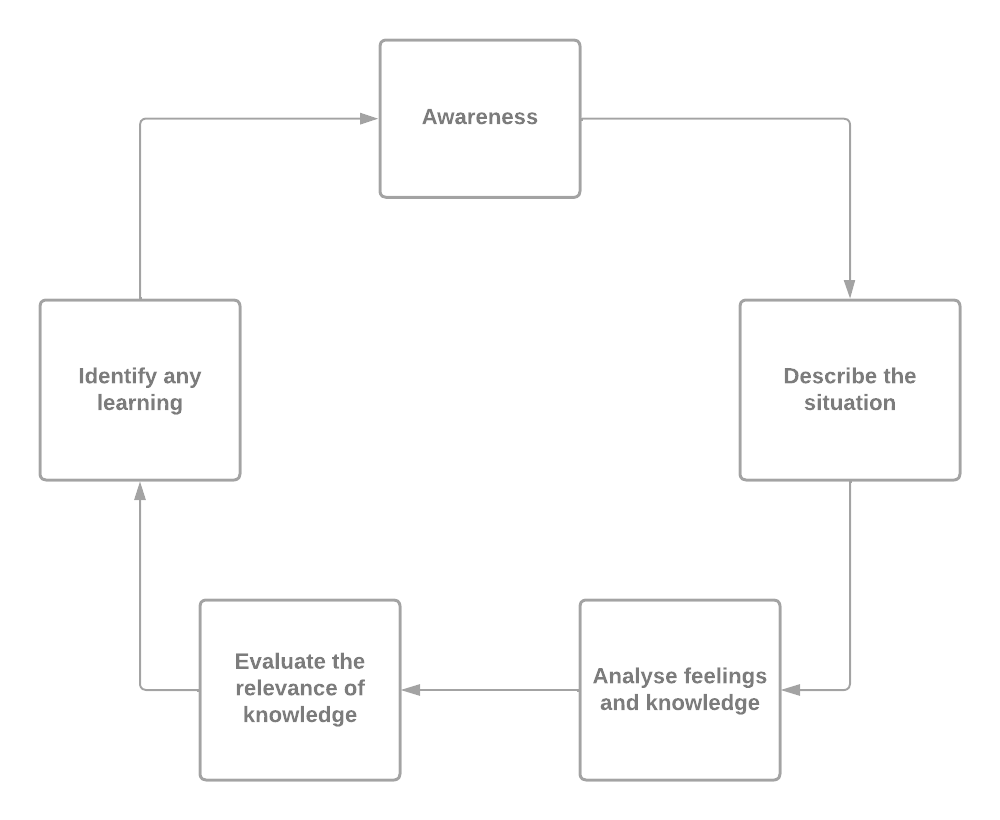
Example question prompts
Awareness
- What happened?
- What influenced my emotions?
- What were my emotions after the situation occurred?
- What was I thinking?
- What am I now thinking looking back at the situation?
Describe the situation
- What was the event?
- Where was the event?
- When did it happen?
- What was my involvement during the event?
- What did other people do?
- What were the key observations?
Analyse feelings and knowledge
- Imagine and explore alternatives
- What did I already know about the situation?
- What were my assumptions about the situation?
- How did reality reflect my assumptions?
- What were the differences?
- How would I react if something else happened?
- In what type of scenarios would the discomfort not occur?
Evaluate the relevance of knowledge
- How does it help to explain the situation?
- How does analyzing different scenarios influence your thoughts?
- How complete was your use of knowledge?
- How can your knowledge next time be useful?
Identify any learning
- What have I learned?
- How can my learnings be used in future situations?
Atkins, S. and Murphy, K. (1994). Reflective Practice. Nursing Standard, 8(39) 49-56.
- Gibbs' Reflective Cycle
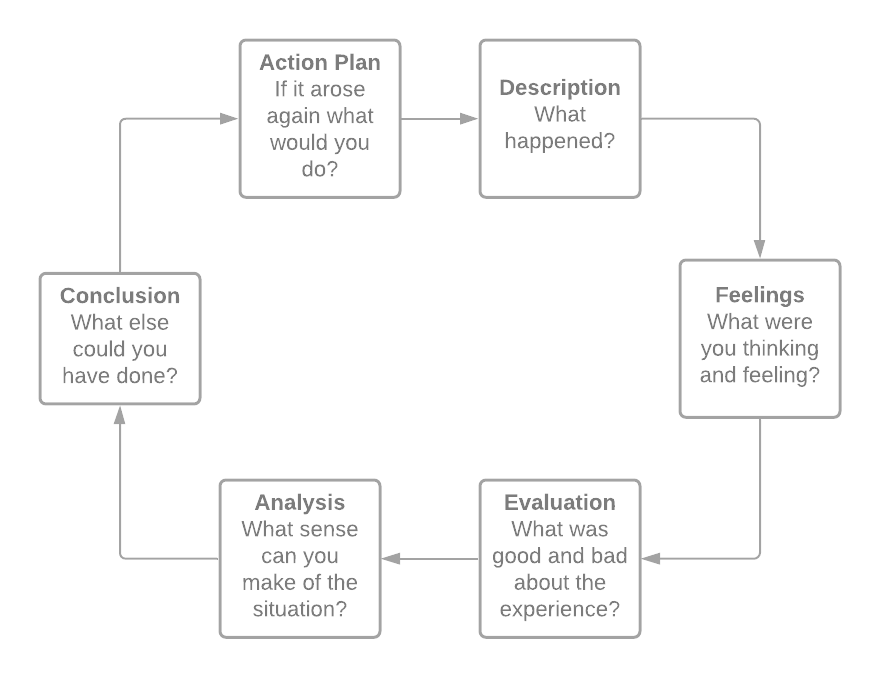
Example question prompts
Description (of the event) What happened?
- What did you do? Where did it happen? Who was involved? What was the context?
Feelings What were you thinking and feeling?
- Describe your internal thoughts and feelings before, during and after the event
Evaluation What was good and bad about the experience?
- Were there things that were difficult? Interesting? Surprising? Upsetting? Provide some judgement about the event and its possible consequences
Analysis What sense can you make of the situation?
- How do past experiences compare to this?
- How does theory or evidence fit with this?
- How did your involvement affect the outcome?
Conclusion What else could you have done?
- What insights, thoughts, or conclusions, about your role within this event that you can now take away?
- What have you learnt for the future?
Action plan What would you do if a similar situation arose again?
- What are some indicators that would help you recognise a similar event?
- What are some changes you would make?
LMS tools that enable reflection activities
The University of Melbourne supports several different tools which can be used in the LMS to facilitate reflection activities.
- H5P
H5P is an open-source tool that easily allows you to create interactive activities, which can be embedded into the LMS. One of the content types available through H5P is the Documentation tool which can be used to prompt students with structured questions they can answer in a longer text response, and generate a document that students can download. You can use its multiple functions to add questions prompts based on one of the reflection models above as shown in the examples below:
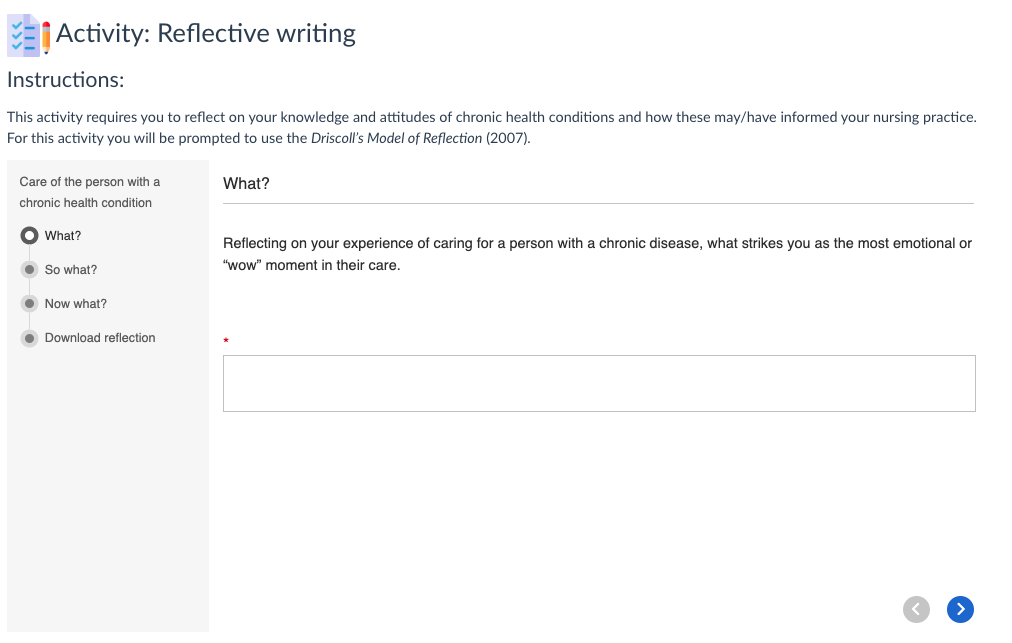
It also includes options for goal setting and self-assessment that you can customise, to give students opportunities to write and reflect on goals or skills they are developing. Or you could use it to prompt students with weekly reflections or as a journal.
More information and guides on H5P.
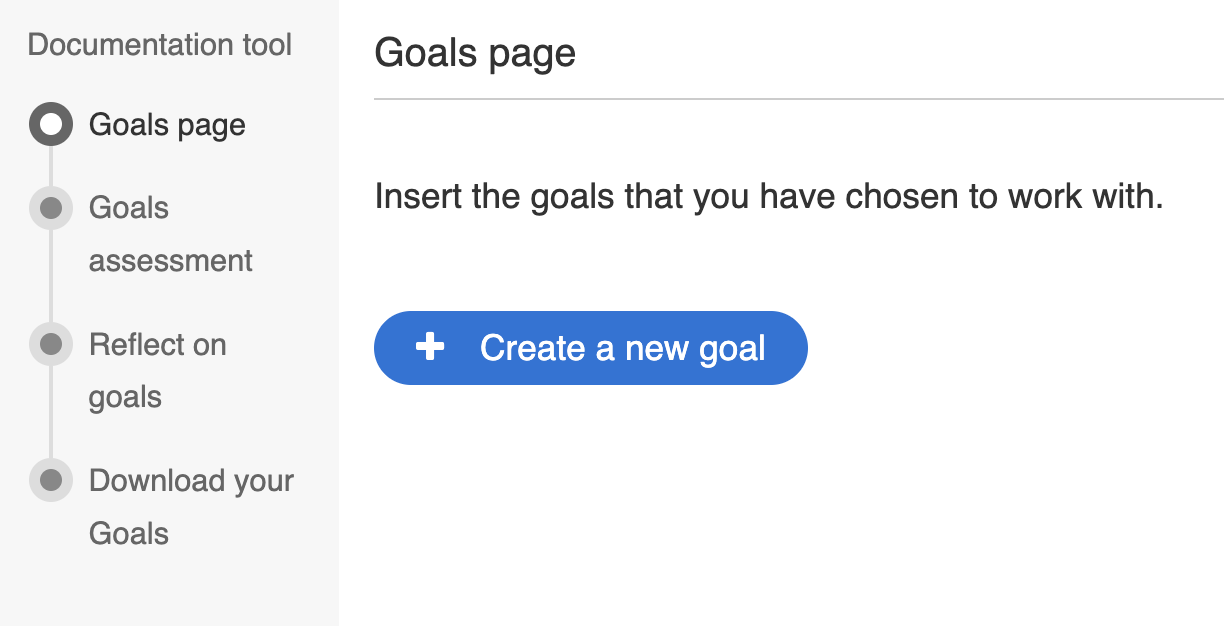
- Cadmus
Cadmus is an online assessment tool, where you create and students complete written assessment tasks in a dedicated environment, accessed through the LMS. For ungraded reflections you can set the assignment to Complete/Incomplete.
Cadmus can be particularly useful for a weekly or regular journal of reflections. It allows you to set the prompts that students can respond to each week, and the document students edit continues to grow as they add to it each time they are required to. Cadmus offers a Reflective Journal template for this purpose which you can edit as needed. For example, you could customise it to prompt students to reflect using one of the models above.
More information and guides on Cadmus.
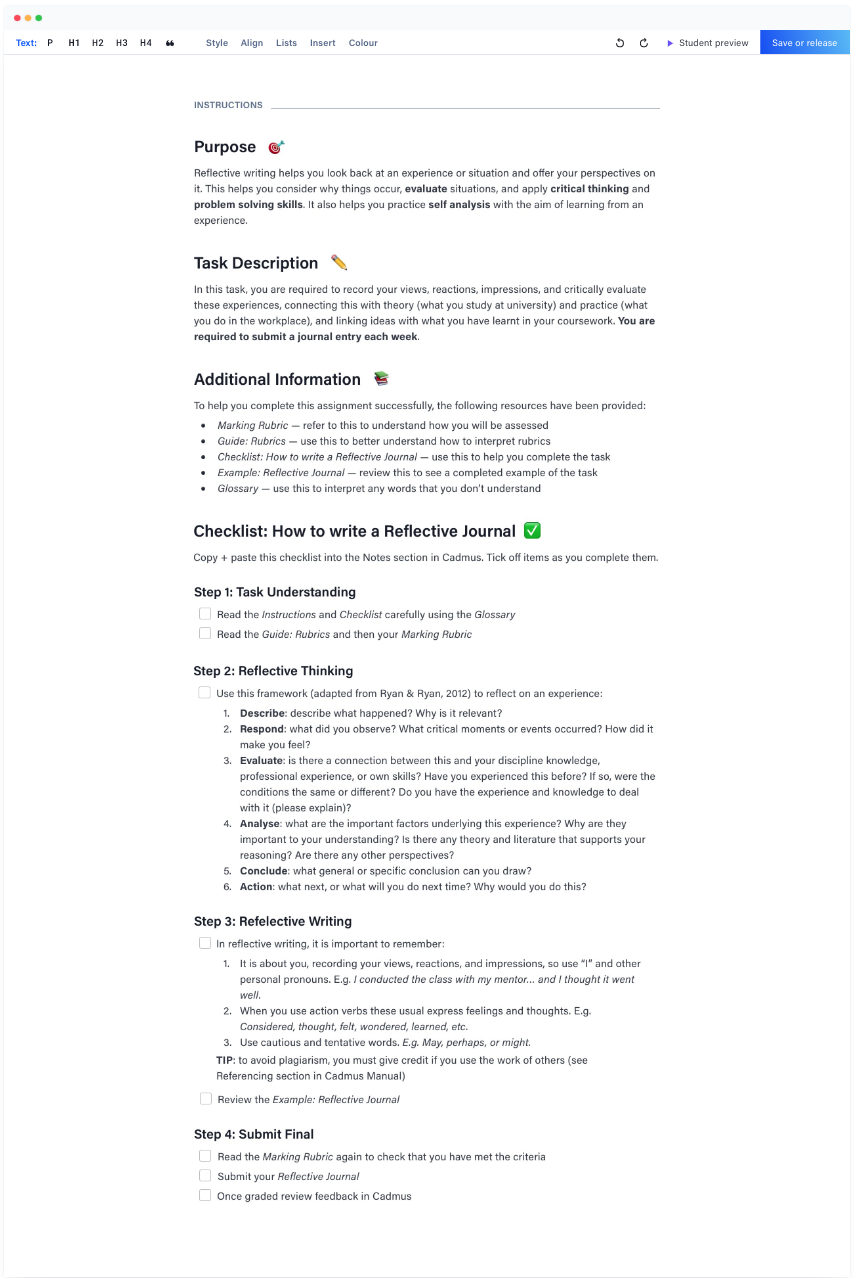
- LMS Quizzes
Many will be familiar with Quizzes in the LMS for the purposes of assessment or as a diagnostic tool. The flexibility Quizzes offer (Graded/Ungraded, Quiz/Survey) and the various Question types allows it to be used for a reflection task. For example, use the Essay question type and add your prompts using one of the models above. This comes with the added bonus of being able to monitor access/completion of the task via New Analytics.
More information and guides on LMS Quizzes.
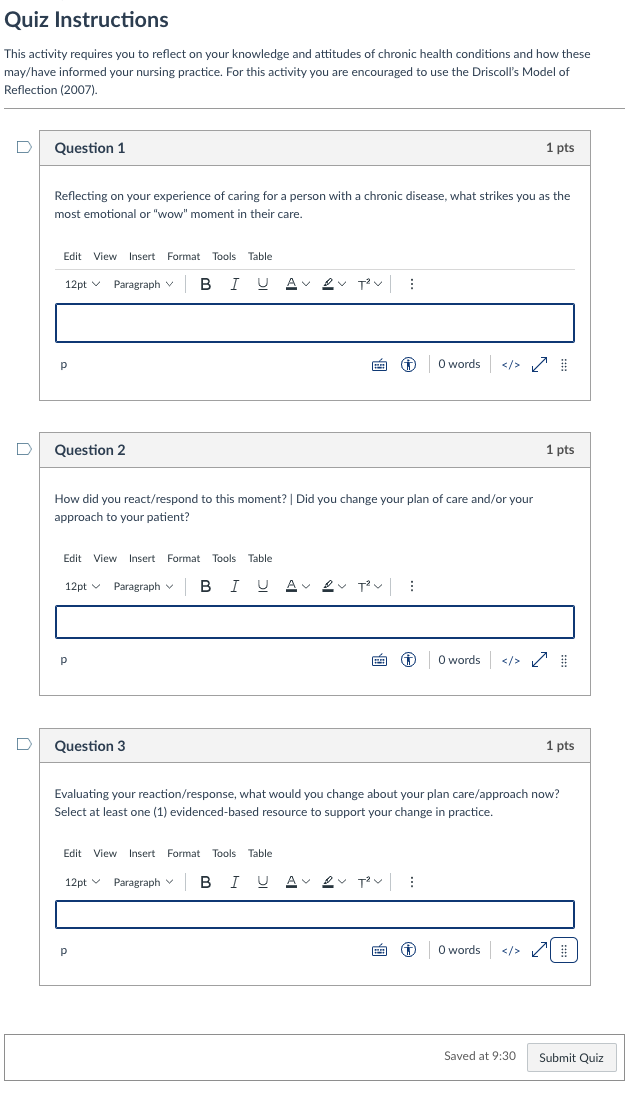
- FeedbackFruits
FeedbackFruits provides a series of tools designed to enhance feedback and student engagement with course content and each other, in the LMS. While not a dedicated reflection tool, Feedback Fruits includes a Reflection ‘module’ that can be added at the end of any of its activity types. This is worth exploring you want students to reflect after an activity in Feedback Fruits such as such as social annotation or peer and self-evaluation.
More information and guides on FeedbackFruits.
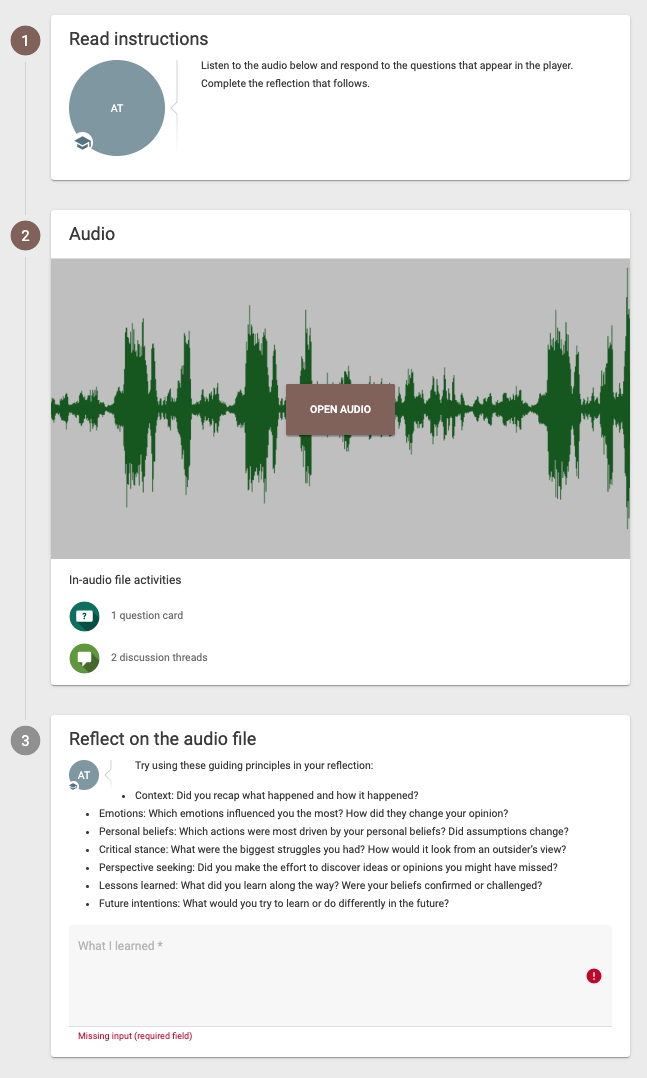
References
- Atkins, S. and Murphy, K. (1994). Reflective Practice. Nursing Standard, 8(39) 49-56.
- Boud D., Keogh R.,Walker D. (1985) ‘Promoting reflection in learning: a model’ in Reflection: Turning experience in to learning, Routledge Falmer, London and New York
- Driscoll, J.J. (2007) Supported reflective learning: the essence of clinical supervision? Chp 2 in Practising Clinical Supervision: A Reflective Approach for Healthcare Professionals (2nd edition). London: Bailliere Tindall. Pp 27-‐50.
- Gibbs G. (1988). Learning by Doing: A guide to teaching and learning methods. London: Further Education Unit.
- Johns C. (2000) Becoming a reflective practitioner: a reflective and holistic approach to clinical nursing practice, development and clinical supervision. Oxford: Blackwell Science.
- Kolb D.A. (1984) Experiential learning: experience as the source of learning and development. Englewoods Cliffs, N.J.: Prentice Hall.
Schön D.A. (1983) The reflective practitioner - how professionals think in action, Basic Books.